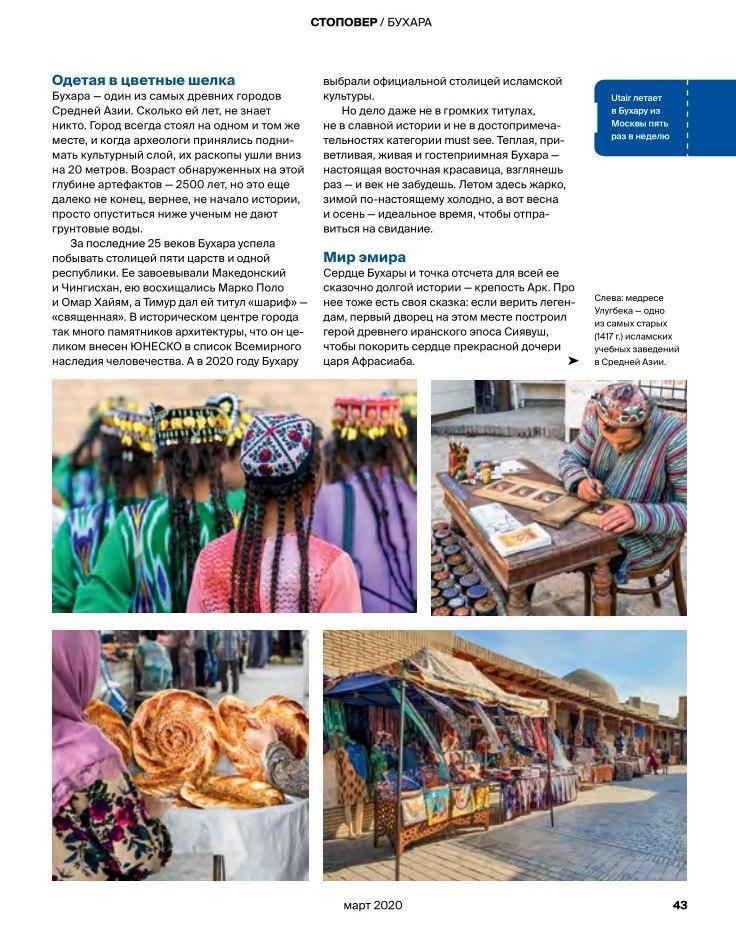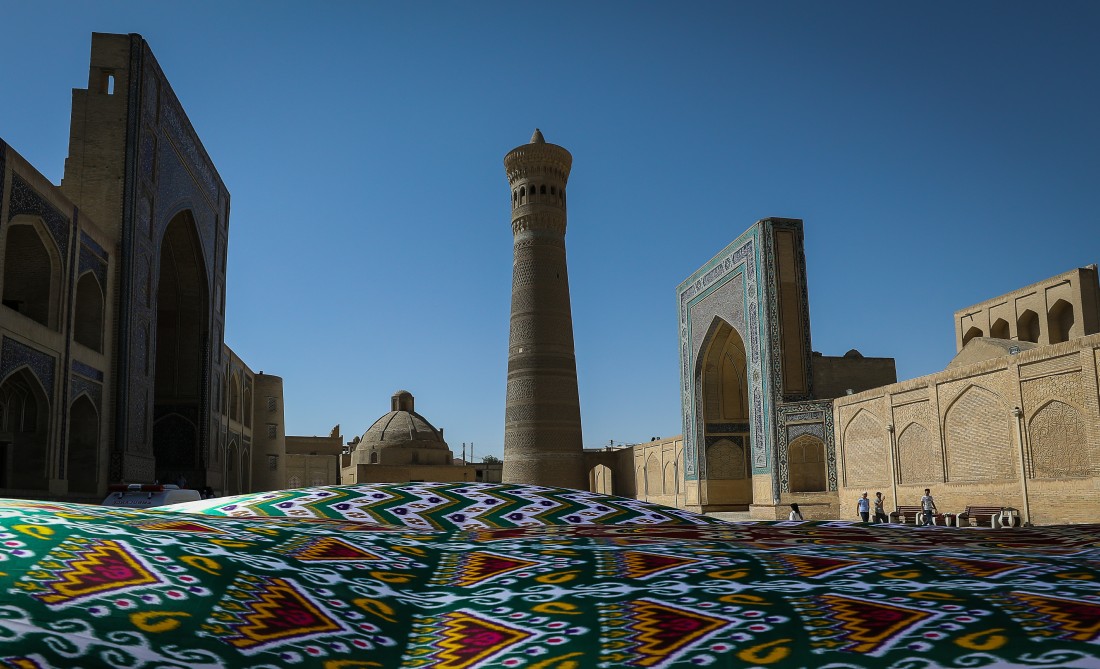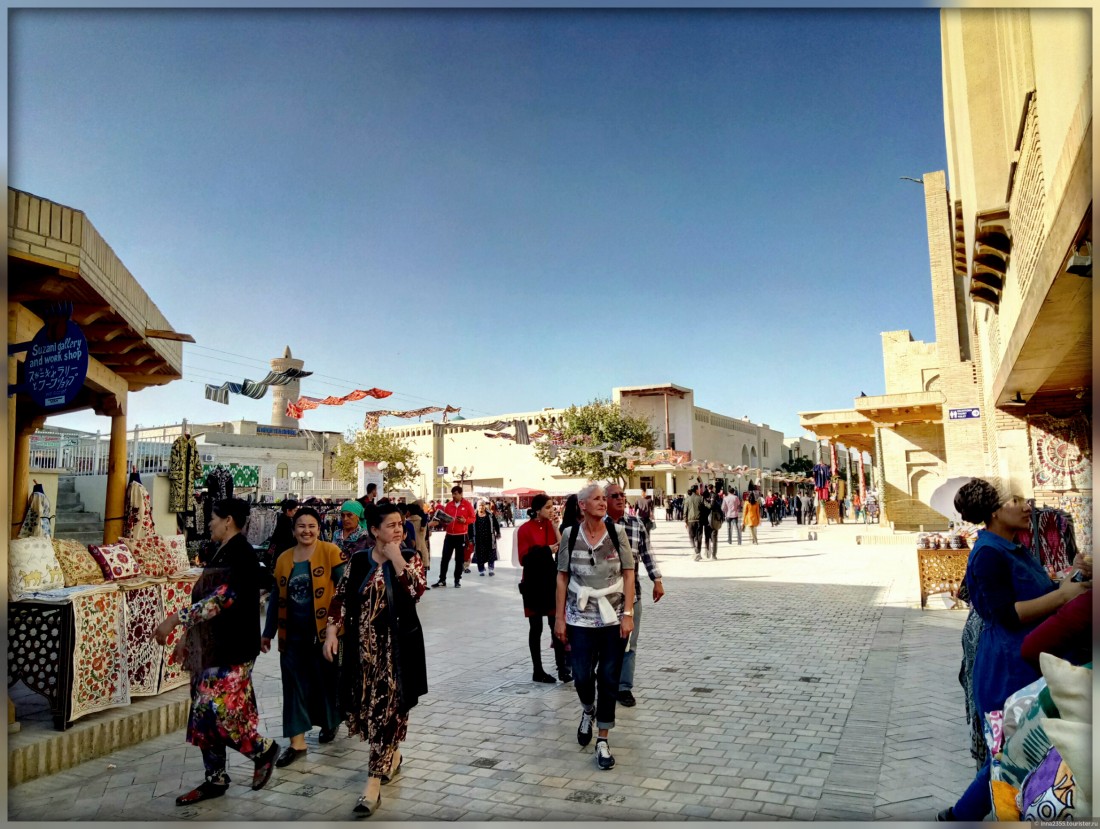Ancient and eternally young Bukhara on the pages of the “UTAIR” on-board magazine

"Bukhara is called the Central Asian Mecca" - the travel journalist Olga Yakovina writes in the article. And recently, it has also become a Mecca for tourists-quite deservedly, because the weekend spent here will be incredibly rich in impressions and at the same time it is also incredibly budget-friendly."
Dressed in colored silks
"No one knows how old she is. The city always stood in the same place, and when the archaeologists began to raise the cultural layer, their excavations went down 20 meters. The age of artifacts found at this depth is 2500 years, but this is far from the end, or rather, not the beginning of history, just to fall below the scientists do not allow the ground water. Over the past 25 centuries, Bukhara has managed to visit the capital of five kingdoms and one republic. It was won by Macedonian and Genghis Khan, it was admired by Marco Polo, and the great Amir Timur gave it the title "Sharif" - "sacred". There are so many architectural monuments in the historical center of the city that it is completely included in the UNESCO World Heritage list. And in 2020, Bukhara was chosen as the official capital of Islamic culture." At the same time, according to the journalist, not only high-profile titles, a glorious history of attractions make Bukhara a city of the "just see" category. Warm, friendly, lively and hospitable atmosphere, that's why tourists love Bukhara.
"This is a real Oriental beauty, look once and you will not forget. It's hot in summer and really cold in winter, but spring and autumn are the perfect time to go on a date."

The world of Emir
Speaking about the sights of Bukhara, Olga Yakovina highlights the Ark fortress, which is the heart of the city and the starting point for all its fabulously long history. "For thousands of years, the citadel was repeatedly destroyed , rebuilt and rebuilt, eventually turning into a real city within the city, standing on a high embankment hill and surrounded by impregnable walls," writes the Russian observer. - Bastions of burnt brick, bristling with wooden drainage channels, were not up to the teeth of many foreign conquerors... Today, the fortress walls have been restored, but most of the citadel lies in ruins. Only a few internal structures have been preserved - the throne hall, the mosque, and individual outbuildings, which are now Museum displays."
Separately, the beauty and grandeur of such monuments as the Samanid Mausoleum, the Chashma Ayub Mausoleum, Chor Minor, the Sitorai Mohihosa Palace, each of which, according to the journalist, is a masterpiece of architecture and a symbol of human genius.
Cultural capital
The name "Bukhara" means "abode of knowledge", the author of the article reports: "From the early Middle Ages to the XIX century, the city was one of the largest centers of world culture and science, where the greatest scientists - Avicenna, Firdousi, Rudaki, Ulugbek, Khayyam and Narshahi studied and worked, and the legendary sage Khoja Nasreddin is believed to have come from Bukhara. In the XVI century, at the time of its greatest prosperity, there were more than two hundred madrasas in the city." It is noted that madrasas, mosques and khanakas (Sufi spiritual abodes) stand opposite each other in pairs, as if inviting to look for similarities and differences between their richly decorated arched facades. This recognizable architectural technique is called "Kosh" and creates an incredible stereo effect, doubling the power of an already powerful aesthetic impact.
"You walk into a building and it's like you're in a kaleidoscope. Symmetrical courtyards with many doors leading to student cells - hujras. Terrace with ayvans with elaborately decorated with columns and painted ceilings. Three-dimensional honeycomb arches-mukarnas and complex ornaments made of brickwork and bright tiles. And everywhere there are no less colorful stalls with souvenirs."

Shopping day
Bukhara's Shahristan (inner city) is an open-air museum. It is also one of the biggest Bazaar. According to O. Yakovina, shopping malls in Bukhara are more impressive than museum displays, and the bazaars themselves could be declared objects of cultural heritage. One of the most important stops of the Great Silk road, Bukhara has always been a city not only of sages, but also of sellers, and only the number of caravanserais could compare with the number of madrassas here.
"Medieval shopping malls stand to this day, without changing their purpose, and from the outside these enfilades under the domes seem like real palaces. Walking through them is not so much a shopping experience as a cultural experience: you can spend hours sorting through and examining what is laid out on the shelves: dressing gowns and skullcaps, silk carpets and hand-embroidered Suzanas, painted plates and chased dishes, silver jewelry and shaggy fur hats."
There is a case
The journalist gives a high rating to the culinary features of great Bukhara. Cafes and teahouses in Shahristan are met at every step, any institution will offer all the main local gastronomic attractions - Samsa, Laghman, stewed fish, kebabs of Gijduvan, writes the correspondent of "UTair".
Special attention is paid to the king of Uzbek national cuisine - Plov:
"In every city of Uzbekistan, pilaf is prepared in its own way, and Bukhara is no exception: the ingredients for Bukhara Osh-I-Sofi are boiled separately and then mixed in a special copper cauldron Degi-mis, adding saffron and dried kishmish. Prepare pilaf (which, by the way, is usually made with beef, not lamb) almost without oil: it turns out, although satisfying, but almost dietary - no wonder the great doctor Avicenna in his writings prescribed to use it as a cure for many diseases."
Leave a comment
By logging in, you agree to the processing personal data
See also
Workhours: 9:00-18:00, Mn-Fr
For any questions
Uzbekistan


 UZB
UZB RUS
RUS JPN
JPN ARA
ARA FRA
FRA CN
CN DE
DE POR
POR ESP
ESP TUR
TUR ITA
ITA HIN
HIN MAL
MAL
A comment